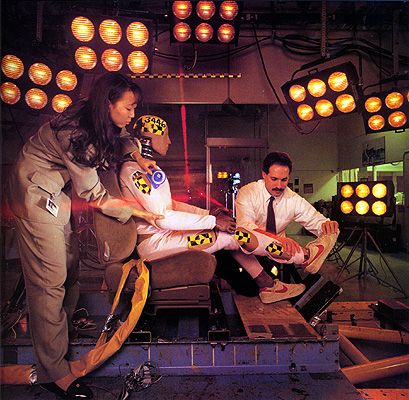| SEATBELT.COM |
[an error occurred while processing this directive]
|
|
EVERYONE
DESERVES TO BE SAFE ON THE ROAD
|
|
|
Search |

At GM labs, engineer Bonnie Cheung and physicist Stephen Rouhana position a Hybrid III dummy (average male size) for a rear-impact crash test. Lasers (shown in red) are used to demarcate exact placement of dummy. mimic a human's. And so dummies are evolving to be more like us. The wearing of seat belts in cars with air bags now reduces a driver's risk of death in a crash by 47 percent. But today's belts and bags were designed for frontal impacts, and standard test dummies were instrumented for front-end crashes. Since federal regulators and carmakers are now scrutinizing side impacts, they need SID, who sprang into being in the 1970s at the National Highway Traffic Safety Administration's behest. In creating SID, designers at the University of Michigan plucked off a standard dummy's arms to prevent flailing, which could throw off measurements in a side crash. They made up for the lost mass by adding weights to SID's spine and ribs. He has steel ribs covered with a vinyl-graphite composite to simulate the response of human ribs to a whacking from the side. In a crash, SID's sensors measure his sideways acceleration. SID is currently the federal standard for ensuring that new cars meet side-impact crashworthiness regulations, However, SID and his clones are now like Neanderthals facing more-advanced Cro-Magnons. |